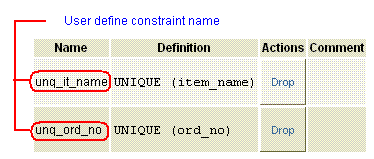Create unique constraint that two numbers together CANNOT together be repeated: PSQL unique constraint on two columns antwoorden feb. Postgres Unique Constraint on two columns : Integer. How to add unique constraint in postgres on two. Meer resultaten van stackoverflow. PostgreSQL multi-column unique constraint and NULL values.
Or use two partial UNIQUE indexes and no complete index (or constraint ). The best solution depends on the details of your requirements. Why do composite foreign keys need a separate unique. Performance of single vs multiple column unique. Creating a UNIQUE constraint on multiple columns.
If you define a UNIQUE index for two or more columns , the combined values in these columns cannot be duplicated in multiple rows. We say that the first two constraints are column constraints, whereas the third one is a. When an index is declared unique, multiple table rows with equal indexed values. Two NULL values for a column in different rows is different and it does not . A unique constraint that applies to all columns that are not NULL.

It could be possible to model this with a number of different unique constraints. So the question is: Does the postgres reader supports multiple key . SQLite FAQ: How do I create a UNIQUE constraint on multiple fields in a SQLite database table? Just specify the unique constraint in your . There is a long discussion on why nullable columns with a UNIQUE constraint can contain multiple NULL values. The short version is that . When using the UNIQUE constraint on multiple columns , the collective values of the columns must be unique.
This does not mean that each value in each . UNIQUE Constraint − Ensures that all values in a column are different. EXCLUSION Constraint − The EXCLUDE constraint ensures that if any two rows are . Multiple column indexes. Note that we were able to add multiple null values for column.

Unique constraints ensure that the data contained in a column , or a group of columns , . However, two null values are never considered equal in this comparison. If you want to index multiple columns : create index concurrently. Unique indexes to prevent duplicate data: create unique index concurrently. There are two ways to define constraints : table constraints and column constraints.
Each unique table constraint must name a set of columns that is different from the. The UNIQUE constraint ensures no duplicate values in a specific column , which. PRIMARY KEY constraint, however, it can have multiple UNIQUE constraints. Because of the search mechanism for unique key constraints on multiple columns , you cannot have identical values in the non-null columns of . To satisfy a UNIQUE constraint , no two rows in the table can have the.
User(BaseModel): username = CharField(unique=True). We have explicitly defined a single username column with a unique constraint. You can also apply a single CHECK constraint to multiple columns by . It can refer to a single column, or multiple columns of the table.
SQLite supports unique constraints that include multiple columns. I guess I might just need to try to throw this into postgres and see how it . Thus the new primary key has two columns : the EMPLOYEE_ID as before. INDEX UNIQUE SCAN —no matter how many columns the index has.
A while I ago I covered the upsert. As well as define a unique key constraint like this: ALTER TABLE .
Geen opmerkingen:
Een reactie posten
Opmerking: Alleen leden van deze blog kunnen een reactie posten.